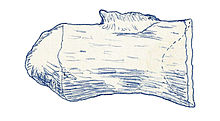Macrurosaurus
|
Macrurosaurus Temporal range: Early Cretaceous |
|
|---|---|
 |
|
| Vertebra | |
| Scientific classification | |
| Kingdom: | Animalia |
| Phylum: | Chordata |
| Class: | Sauropsida |
| Superorder: | Dinosauria |
| Order: | Saurischia |
| Suborder: | Sauropodomorpha |
| Infraorder: | Sauropoda |
| (unranked): | Titanosauriformes |
| Genus: | Macrurosaurus |
| Species: | M. semnus |
| Binomial name | |
|
Macrurosaurus semnus Seeley, 1876 |
|
Macrurosaurus (meaning "large-tailed lizard") is the name given to a genus of dinosaur from the Early Cretaceous. It was a titanosauriform which lived in what is now Europe.
The genus Macrurosaurus was named by Harry Govier Seeley in 1869 but not yet described so that it remained a nomen nudum. In 1876 Seeley described the type species, Macrurosaurus semnus, making the name valid. No other species are known. The generic name is derived from Greek makros, "large", and oura, "tail". The specific name is derived from Greek semnos, "stately" or "impressive".
The holotype of Macrurosaurus, SM B55630, consists of two series of caudal vertebrae found around 1864 near Cambridge, England in the Cambridge Greensand, strata themselves deposited during the Aptian but containing reworked fossil material dating perhaps from around 130 million years ago, the Barremian. The first was acquired by the Woodwardian Museum from William Farren who had it dug up at Coldhams Common near Barnwell. This series is made up of 25 proximal vertebrae. The second was found by Reverend W. Stokes-Shaw at a slightly more western location near Barton. It contained fifteen smaller distal vertebrae, from the tail end. Seeley, acting on the presumption that both finds belonged to the same species if not individual, combined the two series into one tail of about 4.5 metres length.
Other fragmentary fossils from England (Acanthopholis platypus), France and Argentina have later been referred to Macrurosaurus but the identity is today doubted.
...
Wikipedia
